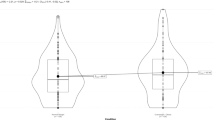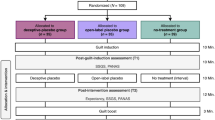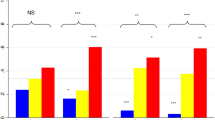Abstract
Objective:
To investigate the influence of a defendant’s weight on simulated jurors’ perceptions of guilt.
Design and methods:
Participants were 471 lean and overweight adults (mean body mass index: 25.34±5.91) who read a vignette describing a case of check fraud while viewing one of four images of the alleged defendant (a lean male, a lean female, an obese male or an obese female). Participants rated the defendant’s culpability on a 5-point Likert scale and completed measures of anti-fat attitudes.
Results:
Male respondents endorsed greater overall weight bias than females (F (1470)=23.815, P<0.01, η2=0.048). A three-way interaction was detected between participant sex, defendant sex and defendant weight on perceptions of guilt such that when the defendant was female, male participants were significantly more likely to find her guilty if she was obese than if she was lean (guilt ratings=4.05±0.83; 3.31±1.03, respectively; F(1467)=5.935, P=0.015, R2=0.060). In addition, lean male participants were significantly more likely to believe that the obese female defendant met criteria for check fraud, and indicated greater belief she would be a repeat offender, compared with the lean female defendant (t(90)=2.081, P=0.040; t(90)=2.395 P=0.019, respectively). There were no differences in perceptions of guilt or responsibility between the obese male and the lean male defendants.
Conclusion:
The results of this novel study indicate that both weight and gender of a defendant may affect juror perceptions of guilt and responsibility.
This is a preview of subscription content, access via your institution
Access options
Subscribe to this journal
Receive 12 print issues and online access
$259.00 per year
only $21.58 per issue
Buy this article
- Purchase on Springer Link
- Instant access to full article PDF
Prices may be subject to local taxes which are calculated during checkout


Similar content being viewed by others
References
Andreyeva T, Puhl R, Brownell K . Changes in perceived weight discrimination among Americans: 1995-1996 through 2004–2006. Obesity 2008; 16: 1129–1134.
Puhl R, Heuer C . The stigma of obesity: a review and update. Obesity 2009; 17: 941–964.
Puhl R, Bias BrownellK . Discrimination, and Obesity. Obesity 2001; 9: 788–805.
Brownell K, Puhl R, Schwartz M, Rudd L . Weight Bias: Nature, Consequences, and Remedies. The Guilford Press: New York, 2005.
Efran MG . The effect of physical appearance on the judgment of guilt, interpersonal attraction, and severity of recommended punishment in a simulated jury task. J Res Pers 1974; 8: 45–54.
Darby BW, Jeffers D . The effects of defendant and juror attractiveness on simulated courtroom trial decisions. Soc Behav Pers: Int J 1988; 16: 39–50.
Sommers SR, Ellsworth PC . Race in the courtroom: perceptions of guilt and dispositional attributions. Pers Soc Psychol Bull 2000; 26: 1367–1379.
Mazzella R, Feingold A . The effects of physical attractiveness, race, socioeconomic status, and gender of defendants and victims on judgments of mock jury: a meta-analysis1. J Appl Soc Psychol 1994; 24: 1315–1338.
Sigall H, Ostrove N . Beautiful but dangerous: Effects of offender attractiveness and nature of the crime on juridic judgment. [Article] J Pers Soc Psychol 1975; 31: 410–414.
Eberhardt JL, Davies PG, Purdie-Vaughns VJ, Johnson SL . Looking deathworthy. Psychol Sci 2006; 17: 383–386.
Hoffman E . Social class correlates of perceived offender typicality. Psychol Rep 1981; 49: 347–350.
Landy D, Aronson E . The influence of the character of the criminal and his victim on the decisions of simulated jurors. J Exp Soc Psychol 1969; 5: 141–152.
Sweeney LT, Haney C . The influence of race on sentencing: a meta-analytic review of experimental studies. Behav Sci Law 1992; 10: 179–195.
Gordon RA, Bindrim TA, McNicholas ML, Walden TL . Perceptions of blue-collar and white-collar crime: the effect of defendant race on simulated juror decisions. J Soc Psychol 1988; 128: 191–197.
Sommers SR, Ellsworth PC . How much do we really know about race and juries – a review of social science theory and research. Chi-Kent L Rev 2003; 78: 997–1031.
Brewer MB . In-group bias in the minimal intergroup situation: A cognitive-motivational analysis. Psychol Bull 1979; 86: 307–324.
Kerr NL, Hymes RW, Anderson AB, Weathers JE . Defendant-juror similarity and mock juror judgments. Law Hum Behav 1995; 19: 545–567.
Stephan CW . Sex prejudice in jury simulation. J Psychol 1974; 88: 305–312.
Burke DM, Ames MA, Etherington R, Pietsch J . Effects of victim’s and defendant’s physical attractiveness on the perception of responsibility in an ambiguous domestic violence case. J Fam Violence 1990; 5: 199–207.
Bernard JL . Interaction between the race of the defendant and that of the jurors in determining verdicts. Law Psychol Rev 1979; 5: 103–111.
Feild H . Rape trials and jurors' decisions. Law Hum Behav 1979; 3: 261–284.
Puhl R, Andreyeva T, Brownell K . Perceptions of weight discrimination: prevalence and comparison to race and gender discrimination in America. Int J Obes 2008; 32: 992–1000.
Pingitore R, Dugoni BL, Tindale RS, Spring B . Bias against overweight job applicants in a simulated employment interview. J Appl Psychol 1994; 79: 909–917.
Crandall CS . Prejudice against fat people: ideology and self-interest. J Pers Soc Psychol 1994; 66: 882–894.
Latner JD, O'Brien KS, Durso LE, Brinkman LA, MacDonald T . Weighing obesity stigma: the relative strength of different forms of bias. Int J Obes 2008; 32: 1145–1152.
Latner JD, Stunkard AJ, Wilson GT . Stigmatized students: age, sex, and ethnicity effects in the stigmatization of obesity. Obesity 2005; 13: 1226–1231.
Abwender DA, Hough K . Interactive effects of characteristics of defendant and mock juror on US participants’ judgment and sentencing recommendations. J Soc Psychol 2001; 141: 603–615.
Foster GD, Wadden TA, Makris AP, Davidson D, Sanderson RS, Allison DB et al. Primary Care physicians' attitudes about obesity and its treatment. Obesity 2003; 11: 1168–1177.
Bray GA, York B, DeLany GA . Survey of the opinions of obesity experts on the causes and treatment of obesity. Am J Clin Nutr 1992; 55: 151–154.
Keppel G . Design and Analysis: A Researcher's Handbook 3rd edn. xiii. Prentice-Hall, Inc: Englewood Cliffs, NJ, US, 1991. pp 594.
Aiken L, West S . Multiple Regression: Testing and Interpreting Interactions. SAGE Publications, Inc: Thousand Oaks, 1991.
Halford GS, Baker R, McCredden JE, Bain JD . How Many Variables Can Humans Process? Psychological Science (Wiley-Blackwell) 2005; 16: 70–76.
Epling JW, Morley CP, Ploutz-Snyder R . Family physician attitudes in managing obesity: a cross-sectional survey study. BMC Res Notes 2011; 4: 473.
Cohen J . Things I have learned (so far). Am Psychol 1990; 45: 1304–1312.
Saville DJ . Multiple comparison procedures: the practical solution. Am Stat 1990; 44: 174–180.
White MA, Masheb RM, Grilo CM . Accuracy of self-reported weight and height in binge eating disorder: misreport is not related to psychological factors. Obesity 2010; 18: 1266–1269.
White MA, Masheb RM, Burke-Martindale C, Rothschild B, Grilo CM . Accuracy of Self-reported weight among bariatric surgery candidates: the influence of race and weight cycling. Obesity 2007; 15: 2761–2768.
Stunkard AJ . The accuracy of self-reported weights. Am J Clin Nutr 1981; 34: 1593.
Sánchez-Vaznaugh EV, Kawachi I, Subramanian SV, Sánchez BN, Acevedo-Garcia D . Do socioeconomic gradients in body mass index vary by race/ethnicity, gender, and birthplace? Am J Epidemiol 2009; 169: 1102–1112.
Pfeifer JE . Ogloff JRP. Ambiguity and Guilt Determinations: A Modern Racism Perspective 1. J Appl Soc Psychol 1991; 21: 1713–1725.
Acknowledgements
Research and project support were provided by the Rudd Center for Food Policy & Obesity.
Author information
Authors and Affiliations
Corresponding author
Ethics declarations
Competing interests
The authors declare no conflict of interest.
Rights and permissions
About this article
Cite this article
Schvey, N., Puhl, R., Levandoski, K. et al. The influence of a defendant’s body weight on perceptions of guilt. Int J Obes 37, 1275–1281 (2013). https://doi.org/10.1038/ijo.2012.211
Received:
Revised:
Accepted:
Published:
Issue Date:
DOI: https://doi.org/10.1038/ijo.2012.211
Keywords
This article is cited by
-
Disability Discrimination and Obesity: The Big Questions?
Current Obesity Reports (2015)



